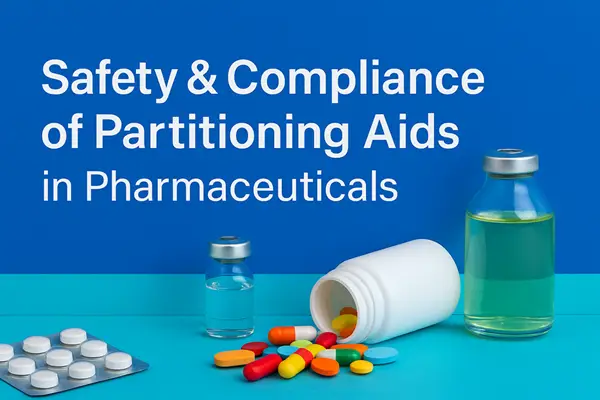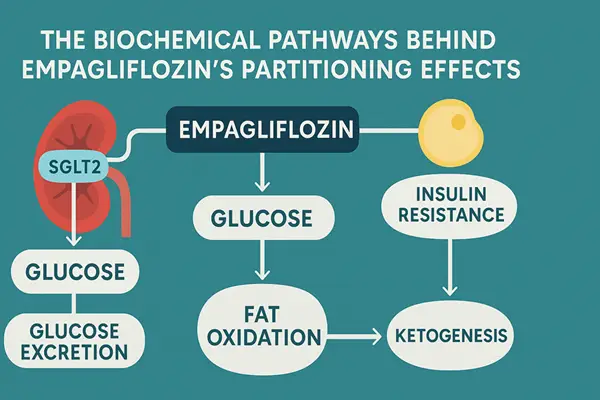Partitioning aids are widely used in pharmaceutical development to improve the solubility, stability, or absorption of active pharmaceutical ingredients (APIs). They can be the difference between a drug that works effectively and one that fails to deliver the required therapeutic effect. However, their use comes with responsibilities. Every excipient in a medicine must be assessed for safety, quality, and compliance with international standards, since patients rely on these formulations to be both safe and effective.
This article explores the potential risks of partitioning aids, the types of excipients that are generally acceptable, the quality control measures needed to manage them, and the regulatory standards that govern their use.
What are partitioning aids?
Partitioning aids are substances added to drug formulations to influence how APIs distribute between different phases, such as oil and water, or how they interact with solvents and excipients. By altering these interactions, partition aids can make poorly soluble drugs more bioavailable, stabilise formulations during storage, and support consistent manufacturing outcomes.
Common partitioning aids include surfactants, lipids, and certain polymers. For example, polysorbates are used to enhance solubility, while polyethylene glycol (PEG) derivatives may improve the stability of proteins and peptides. These materials are not active drugs themselves but are essential excipients that determine whether the medicine reaches the patient in a safe and reliable form.
Risks associated with partitioning aids
While partitioning aids can add value, they also introduce potential risks.
- Toxicity: Some excipients may have toxic effects if used at high concentrations. For example, certain surfactants can cause irritation or organ stress if limits are exceeded.
- Interactions with APIs: Partitioning aids can alter the pharmacokinetics of a medicine, sometimes changing the way an API is absorbed or metabolised. This could reduce therapeutic effect or increase side effects.
- Stability concerns: An excipient that is not well matched to the API can cause degradation, leading to a shorter shelf life or reduced potency.
- Patient tolerability: Acceptability is a key factor. Some patients may experience allergic reactions or intolerance to specific excipients, particularly in sensitive groups such as children, elderly patients, or individuals with dietary restrictions.
Understanding and managing these risks is a critical part of pharmaceutical development. Every partitioning aid must be selected with evidence to demonstrate that it is safe for the intended patient group and compatible with the drug substance.
Acceptable excipients in pharmaceutical use
Excipients used as partitioning aids are expected to come from pharmacopeial listings such as the European Pharmacopoeia, the British Pharmacopoeia, or the United States Pharmacopeia. Inclusion in these references means the excipient has established standards for identity, purity, and acceptable limits.
Examples of widely accepted excipients include:
- Polysorbates (Tween 20, Tween 80): Used as surfactants to improve solubility.
- Polyethylene glycols (PEGs): Often used in protein stabilisation or controlled-release formulations.
- Phospholipids: Key in lipid-based delivery systems and liposomal drugs.
- Cyclodextrins: Used to enhance solubility and stability of certain compounds.
Even excipients with a long history of use must be justified for each new formulation. An ingredient safe in one dosage form may behave differently in another. For example, an excipient tolerated in oral tablets may cause issues if used in injectable medicines.
Quality control requirements
Robust quality control is non-negotiable in the use of partitioning aids. Manufacturers must ensure that excipients meet rigorous standards for identity, purity, and performance.
Key aspects include:
- Identity testing: Techniques such as infrared spectroscopy or chromatography confirm that the material is the correct substance.
- Purity testing: Excipients must be tested for contaminants, residual solvents, heavy metals, and microbial content. This ensures patient safety and compliance with International Council for Harmonisation (ICH) guidelines.
- Batch consistency: Variations between batches can cause unpredictable drug performance. Manufacturers must confirm uniformity through validated testing methods.
- Stability testing: Excipients should remain stable under storage and manufacturing conditions. Any breakdown products must be assessed for safety.
Supplier qualification is also part of quality control. Pharmaceutical companies are expected to audit their suppliers, verify certificates of analysis, and maintain strict oversight to ensure excipients are produced under good manufacturing practice (GMP).
Regulatory standards
Partitioning aids are tightly regulated worldwide. Key requirements include:
- Pharmacopeial compliance: Excipients should meet recognised pharmacopeial standards, which define specifications for purity, quality, and performance.
- Regulatory approval: Use of a partitioning aid must be justified in regulatory submissions to authorities such as the European Medicines Agency (EMA), the UK Medicines and Healthcare Products Regulatory Agency (MHRA), or the US Food and Drug Administration (FDA).
- Toxicological evaluation: Safety data must be provided for all excipients, particularly if they are novel or not widely used in authorised pharmaceutical products.
- ICH guidance: International guidelines set detailed requirements. For example, ICH Q3C covers residual solvents, ICH Q3D covers elemental impurities, and ICH Q8 focuses on pharmaceutical development principles.
By following these standards, pharmaceutical manufacturers can demonstrate that their products are safe for patients and suitable for approval in global markets.
Post-approval monitoring
The responsibility does not end once a medicine is approved. Partitioning aids must continue to be monitored throughout the product lifecycle. Pharmacovigilance activities help identify any previously unknown risks, while periodic audits of suppliers ensure quality is maintained.
In some cases, excipients have been reformulated or substituted after approval due to emerging safety concerns. A well-documented monitoring system helps ensure that any issues are addressed quickly to protect patient health.
Practical considerations for manufacturers
Pharmaceutical companies can more effectively manage the use of partitioning aids by:
- Building excipient risk assessments into early development stages
- Working closely with excipient suppliers to verify compliance with GMP
- Conducting stress tests and stability studies that include excipient interactions
- Preparing clear regulatory justifications for every excipient in a formulation
- Establishing robust post-marketing monitoring procedures
These steps reduce the risk of regulatory rejection and strengthen confidence in the safety and reliability of the medicine.
Final thoughts
Partitioning aids are valuable tools in modern drug development, helping medicines achieve the solubility, stability, and bioavailability required for patient benefit. Yet their use must always be balanced with careful safety assessment, thorough quality control, and strict regulatory compliance. By selecting acceptable excipients, verifying their quality through GMP, and adhering to international standards, pharmaceutical companies can ensure that partitioning aids support innovation without compromising patient safety. Ultimately, the responsible use of these aids contributes to the development of safe, effective, and high-quality medicines that meet the expectations of both regulators and patients.


